Dell DC01L, GX404 User Manual

book.book Page 1 Tuesday, November 27, 2007 10:29 AM
Dell™ XPS™ 420 Owner’s Manual
Model DC01L
w w w . d e l l . c o m | s u p p o r t . d e l l . c o m
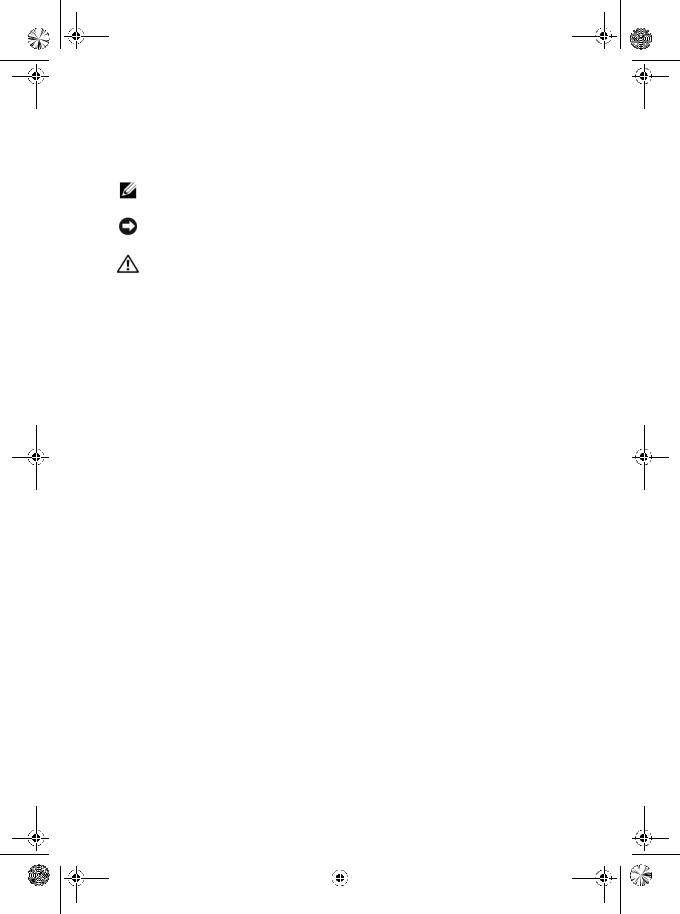
book.book Page 2 Tuesday, November 27, 2007 10:29 AM
Notes, Notices, and Cautions
NOTE: A NOTE indicates important information that helps you make better use of your computer.
NOTICE: A NOTICE indicates either potential damage to hardware or loss of data and tells you how to avoid the problem.
CAUTION: A CAUTION indicates a potential for property damage, personal injury, or death.
If you purchased a Dell™ n Series computer, any references in this document to Microsoft® Windows® operating systems are not applicable.
____________________
Information in this document is subject to change without notice. © 2007 Dell Inc. All rights reserved.
Reproduction in any manner whatsoever without the written permission of Dell Inc. is strictly forbidden.
Trademarks used in this text: Dell, the DELL logo, XPS, Dell TravelLite, the Dell Media Xcelerator, Yours Is Here, and StrikeZone are trademarks of Dell Inc.; Intel, Pentium, Intel Core 2 Extreme , Intel Core 2 Duo, Intel Core 2 Quad, Intel SpeedStep, and Intel ViiV are either trademarks or registered trademarks of Intel Corporation; Microsoft, Windows, Windows Vista, Outlook, SideShow,and the
Windows Vista Start button are either trademarks or registered trademarks of Microsoft Corporation in the United States and/or other countries; Blu-ray Disc is a trademark of the Blu-ray Disc Association; Bluetooth is a registered trademark owned by Bluetooth SIG, Inc. and is used by Dell under license.
Other trademarks and trade names may be used in this document to refer to either the entities claiming the marks and names or their products. Dell Inc. disclaims any proprietary interest in trademarks and trade names other than its own.
Model DC01L
November 2007 |
P/N GX404 |
Rev. A01 |
||
|
|
|
|
|
|
|
|
|
|
|
|
|
|
|
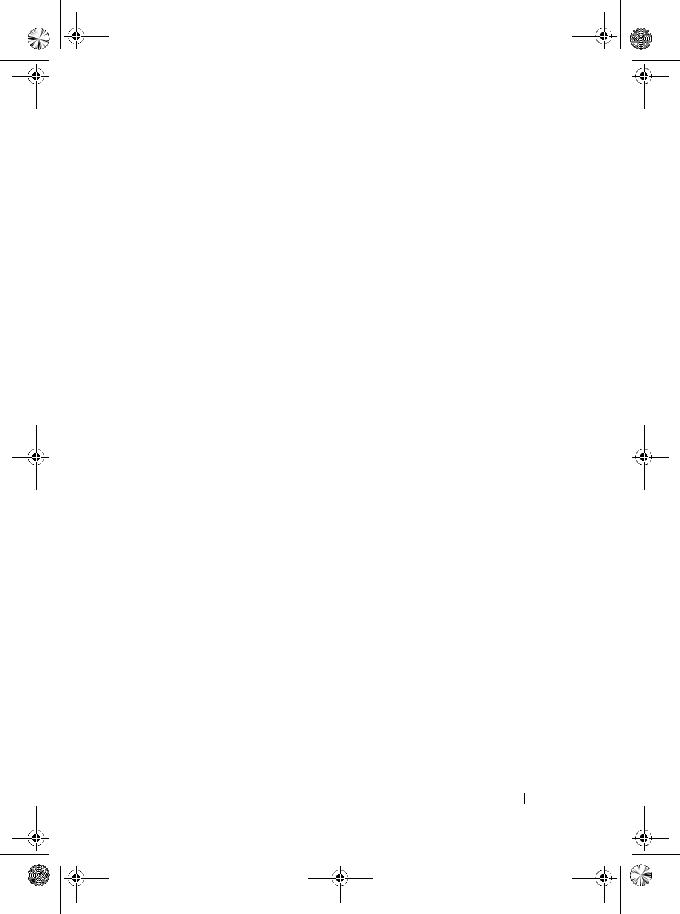
book.book Page 3 Tuesday, November 27, 2007 10:29 AM
Contents
Finding Information . . . . . . . . . . . . . . . . . . . |
11 |
1 Setting Up and Using Your Computer . . . |
15 |
Front and Back View of the Computer . . . . . . . . . |
15 |
Front View . . . . . . . . . . . . . . . . . . . . . |
15 |
Front I/O Connectors . . . . . . . . . . . . . . . . |
18 |
Back View . . . . . . . . . . . . . . . . . . . . . |
19 |
Back I/O Connectors . . . . . . . . . . . . . . . . |
20 |
Installing Your Computer in an Enclosure . . . . . . . |
22 |
Connecting Monitors . . . . . . . . . . . . . . . . . . |
24 |
Connecting a Monitor (Without an Adapter) . . . . |
25 |
Connecting a Monitor (With an Adapter) . . . . . |
26 |
Connecting Two or More Monitors . . . . . . . . |
28 |
Connecting a TV . . . . . . . . . . . . . . . . . . |
29 |
Changing the Display Settings . . . . . . . . . . . |
30 |
About Your RAID Configuration . . . . . . . . . . . . . |
30 |
RAID Level 0 Configuration . . . . . . . . . . . . . |
30 |
RAID Level 1 Configuration . . . . . . . . . . . . . |
31 |
Configuring Your Computer for RAID . . . . . . . . |
32 |
Using the Intel® RAID Option ROM Utility . . . . . |
33 |
Using the Intel® Application Accelerator . . . . . |
36 |
Dell DataSafe (Optional) . . . . . . . . . . . . . . . . |
41 |
Contents 3

book.book Page 4 Tuesday, November 27, 2007 10:29 AM
Intel® Viiv™ Technology (Optional) . . . . . . . . . . . |
41 |
Using Intel Viiv Quick Resume |
|
Technology (QRT) . . . . . . . . . . . . . . . . . . |
41 |
Enabling the QRT Feature in System Setup . . . . |
42 |
Enabling the QRT Feature in the Operating |
|
System . . . . . . . . . . . . . . . . . . . . . . . |
42 |
Using Multimedia . . . . . . . . . . . . . . . . . . . . |
42 |
Playing CDs or DVDs . . . . . . . . . . . . . . . . |
42 |
Copying Media . . . . . . . . . . . . . . . . . . . . . . |
44 |
How to Copy a CD or DVD . . . . . . . . . . . . . |
44 |
How to Copy a Blu-ray Disc™ (BD) Media . . . . . |
45 |
Using Blank CDs and DVDs . . . . . . . . . . . . |
45 |
Helpful Tips . . . . . . . . . . . . . . . . . . . . . |
46 |
Using a Media Card Reader . . . . . . . . . . . . . . |
47 |
Understanding the Media Xcelerator™ (Optional) . . . |
49 |
Understanding Windows® SideShow™ and the |
|
LCD display . . . . . . . . . . . . . . . . . . . . . . . |
50 |
Configuring the LCD display . . . . . . . . . . . . |
51 |
Adding Gadgets To LCD Display Menu . . . . . . . |
51 |
Setting Up a Printer . . . . . . . . . . . . . . . . . . . |
52 |
Printer Cable . . . . . . . . . . . . . . . . . . . . |
52 |
Connecting a USB Printer . . . . . . . . . . . . . |
52 |
Connecting to the Internet . . . . . . . . . . . . . . . . |
54 |
Setting Up Your Internet Connection . . . . . . . . |
54 |
Network Setup Wizard . . . . . . . . . . . . . . . . . |
55 |
Transferring Information to a New Computer . . . . . . |
56 |
4 Contents

book.book Page 5 Tuesday, November 27, 2007 10:29 AM
Power Management Options in Windows Vista . . . . |
56 |
Sleep Mode . . . . . . . . . . . . . . . . . . . . |
56 |
Hybrid Sleep . . . . . . . . . . . . . . . . . . . . |
56 |
Hibernate Mode . . . . . . . . . . . . . . . . . . |
57 |
Configuring Power Management Settings . . . . . |
57 |
2 Optimizing for Greater Performance . . . . |
59 |
|
|
|||
Understanding Intel™ SpeedStep® Technology . . . . |
59 |
|
|
|||
3 Troubleshooting . . . . . . . . . . . . . . . . . . . |
61 |
|
|
|||
Solving Problems . . . . . . . . . . . . . . . . . . . . |
61 |
|
|
|||
Coin-Cell Battery Problems . . . . . . . . . . . . |
61 |
|
|
|||
Drive Problems . . . . . . . . . . . . . . . . . . . |
62 |
|
|
|||
E-Mail, Modem, and Internet Problems . . . . . . |
63 |
|
|
|||
Error Messages . . . . . . . . . . . . . . . . . . |
64 |
|
|
|||
IEEE 1394a Device Problems . . . . . . . . . . . . |
65 |
|
|
|||
Keyboard Problems . . . . . . . . . . . . . . . . |
65 |
|
|
|||
Lockups and Software Problems . . . . . . . . . |
66 |
|
|
|||
Memory Problems . . . . . . . . . . . . . . . . . |
68 |
|
|
|||
Mouse Problems . . . . . . . . . . . . . . . . . |
68 |
|
|
|||
Network Problems . . . . . . . . . . . . . . . . . |
69 |
|
|
|||
Power Problems . . . . . . . . . . . . . . . . . . |
69 |
|
|
|||
Printer Problems . . . . . . . . . . . . . . . . . . |
71 |
|
|
|||
Scanner Problems . . . . . . . . . . . . . . . . . |
71 |
|
|
|||
Sound and Speaker Problems . . . . . . . . . . . |
72 |
|
|
|||
Video and Monitor Problems . . . . . . . . . . . . |
73 |
|
|
|||
Power Lights . . . . . . . . . . . . . . . . . . . . . . |
75 |
|
|
|||
Diagnostic Lights . . . . . . . . . . . . . . . . . . . . |
76 |
|
|
|||
Beep Codes . . . . . . . . . . . . . . . . . . . . . . . |
81 |
|
|
|||
|
|
|
Contents |
|
|
5 |
|
||||||
|
|
|
|
|
|
|
|
|
|
|
|
|
|
|
|
|
|
|
|
|
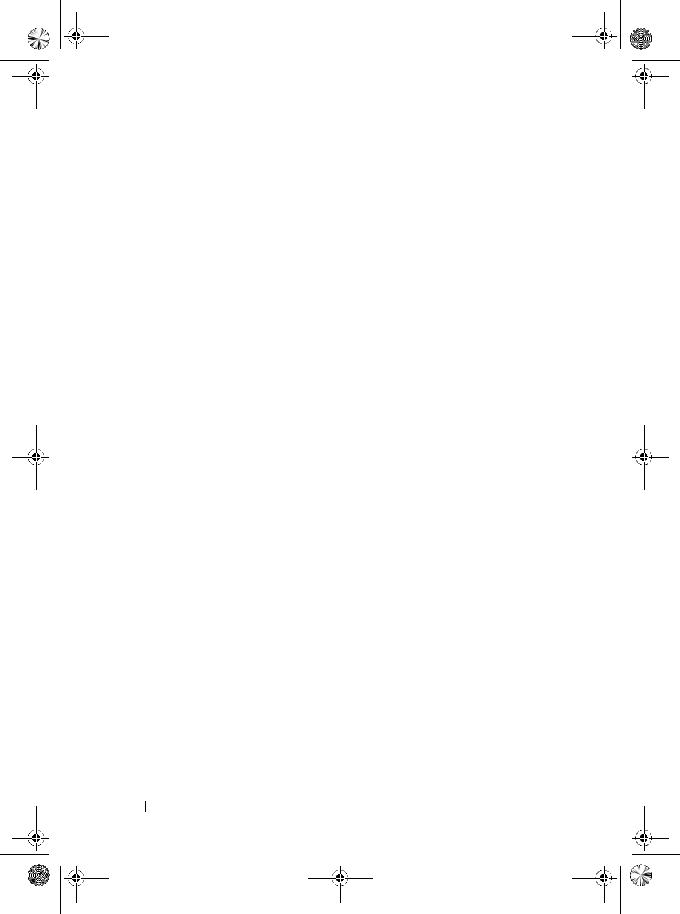
book.book Page 6 Tuesday, November 27, 2007 10:29 AM
System Messages . . . . . . . . . . . . . . . . . . . . |
83 |
Dell Diagnostics . . . . . . . . . . . . . . . . . . . . . |
86 |
When to Use Dell Diagnostics . . . . . . . . . . . |
86 |
Starting Dell Diagnostics From Your |
|
Hard Drive . . . . . . . . . . . . . . . . . . . . . |
87 |
Starting Dell Diagnostics From the Drivers and |
|
Utilities Media . . . . . . . . . . . . . . . . . . . |
88 |
Dell Diagnostics Main Menu . . . . . . . . . . . . |
88 |
Drivers . . . . . . . . . . . . . . . . . . . . . . . . . . |
90 |
What Is a Driver? . . . . . . . . . . . . . . . . . . |
90 |
Identifying Drivers . . . . . . . . . . . . . . . . . |
91 |
Reinstalling Drivers and Utilities . . . . . . . . . . |
91 |
Using Windows Device Driver Rollback . . . . . . |
91 |
Using the Drivers and Utilities Media . . . . . . . |
92 |
Troubleshooting Software and Hardware Problems |
|
in the Microsoft Windows Vista™ Operating |
|
System . . . . . . . . . . . . . . . . . . . . . . . . . . |
93 |
Restoring Your Operating System . . . . . . . . . . . . |
94 |
Using Microsoft Windows System Restore . . . . |
94 |
Using Dell Factory Image Restore . . . . . . . . . |
95 |
Using the Operating System Media . . . . . . . . |
96 |
Troubleshooting LCD Display Problems . . . . . . . . . |
98 |
4 Removing and Installing Parts . . . . . . . . |
99 |
Before You Begin . . . . . . . . . . . . . . . . . . . . |
99 |
Recommended Tools . . . . . . . . . . . . . . . . |
99 |
Turning Off Your Computer . . . . . . . . . . . . . |
99 |
Before Working Inside Your Computer . . . . . . . |
100 |
Removing the Computer Cover . . . . . . . . . . . . . |
101 |
6 Contents
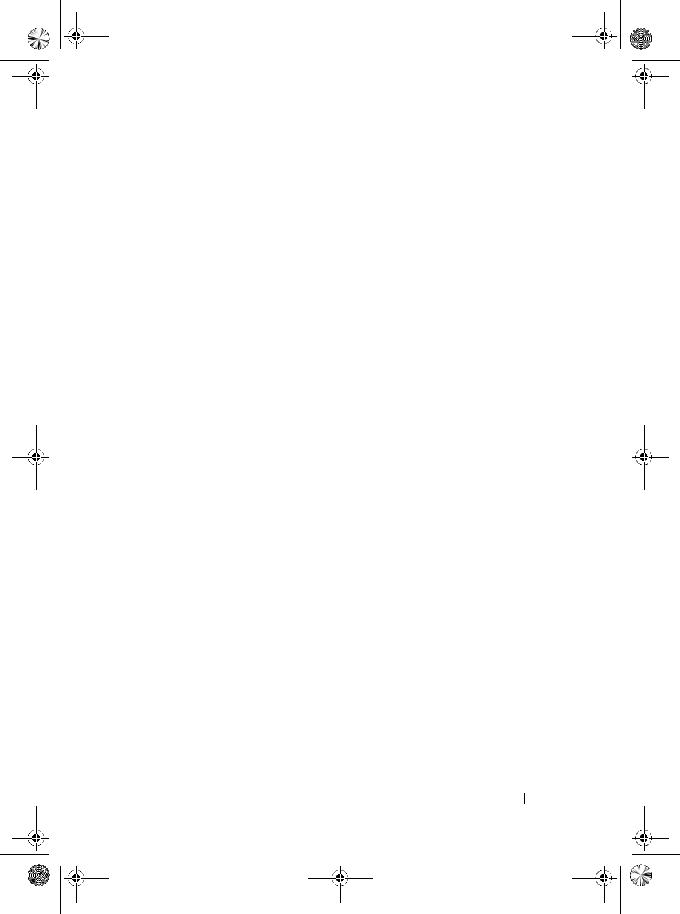
book.book Page 7 Tuesday, November 27, 2007 10:29 AM
Inside View of Your Computer . . . . . . . . . . . . . |
102 |
System Board Components . . . . . . . . . . . . . . . |
103 |
Memory . . . . . . . . . . . . . . . . . . . . . . . . . |
104 |
Memory Overview . . . . . . . . . . . . . . . . . |
104 |
Installing Memory . . . . . . . . . . . . . . . . . |
106 |
Removing Memory . . . . . . . . . . . . . . . . . |
108 |
Cards . . . . . . . . . . . . . . . . . . . . . . . . . . . |
109 |
PCI Cards . . . . . . . . . . . . . . . . . . . . . . |
109 |
PCI Express Cards . . . . . . . . . . . . . . . . . |
115 |
Drive Panels . . . . . . . . . . . . . . . . . . . . . . . |
124 |
Removing the Drive Panel . . . . . . . . . . . . . |
124 |
Removing the Drive-Panel Insert . . . . . . . . . |
125 |
Replacing the Drive-Panel Insert . . . . . . . . . |
126 |
Replacing the Drive Panel . . . . . . . . . . . . . |
127 |
Drives . . . . . . . . . . . . . . . . . . . . . . . . . . |
128 |
General Installation Guidelines . . . . . . . . . . |
128 |
Hard Drive . . . . . . . . . . . . . . . . . . . . . . . . |
129 |
Removing a Hard Drive . . . . . . . . . . . . . . . |
129 |
Installing a Hard Drive . . . . . . . . . . . . . . . |
130 |
Adding a Second Hard Drive . . . . . . . . . . . . |
132 |
Installing a Hard Drive in the FlexBay . . . . . . . |
134 |
Removing a Hard Drive From the FlexBay . . . . . |
135 |
Floppy Drive . . . . . . . . . . . . . . . . . . . . . . . |
136 |
Removing a Floppy Drive . . . . . . . . . . . . . . |
136 |
Installing a Floppy Drive . . . . . . . . . . . . . . |
138 |
Media Card Reader . . . . . . . . . . . . . . . . . . . |
140 |
Removing a Media Card Reader . . . . . . . . . . |
140 |
Installing a Media Card Reader . . . . . . . . . . |
142 |
Contents 7
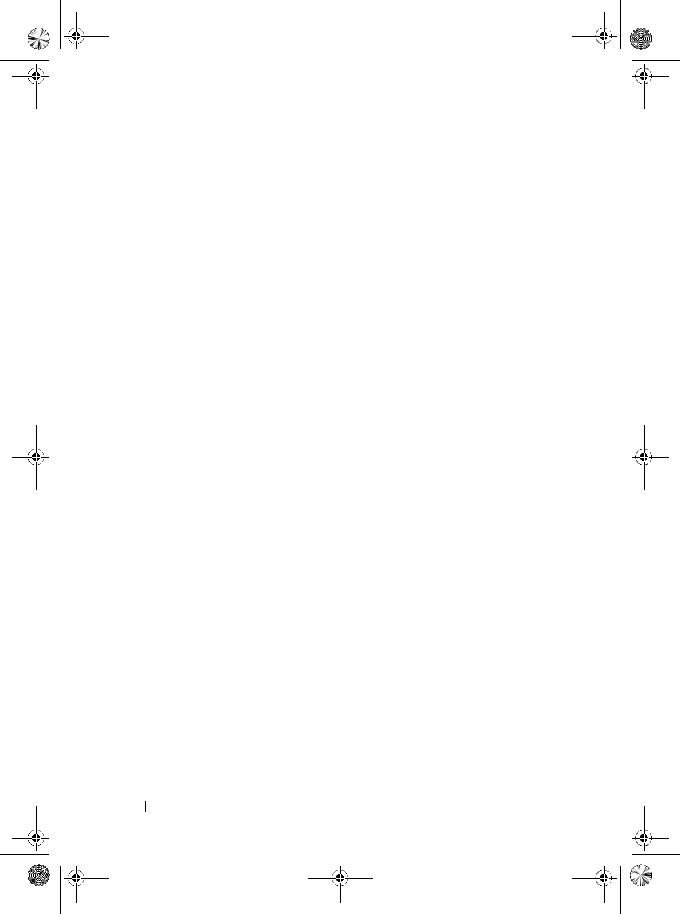
book.book Page 8 Tuesday, November 27, 2007 10:29 AM
CD/DVD Drive . . . . . . . . . . . . . . . . . . . . . . |
144 |
Removing a CD/DVD Drive . . . . . . . . . . . . . |
144 |
Installing a CD/DVD Drive . . . . . . . . . . . . . |
146 |
Processor Airflow Shroud . . . . . . . . . . . . . . . . |
148 |
Removing the Processor Airflow Shroud |
|
Assembly . . . . . . . . . . . . . . . . . . . . . . |
148 |
Installing the Processor Airflow Shroud |
|
Assembly . . . . . . . . . . . . . . . . . . . . . . |
149 |
Fans . . . . . . . . . . . . . . . . . . . . . . . . . . . |
149 |
Removing the Processor Fan Cage . . . . . . . . |
149 |
Installing the Processor Fan Cage . . . . . . . . . |
150 |
Removing the Processor Fan . . . . . . . . . . . . |
151 |
Installing the Processor Fan . . . . . . . . . . . . |
152 |
Removing the Card Fan . . . . . . . . . . . . . . . |
152 |
Installing the Card Fan . . . . . . . . . . . . . . . |
154 |
Processor . . . . . . . . . . . . . . . . . . . . . . . . |
154 |
Removing the Processor . . . . . . . . . . . . . . |
154 |
Installing the Processor . . . . . . . . . . . . . . |
155 |
System Board . . . . . . . . . . . . . . . . . . . . . . |
157 |
Removing the System Board . . . . . . . . . . . . |
157 |
Installing the System Board . . . . . . . . . . . . |
158 |
Power Supply . . . . . . . . . . . . . . . . . . . . . . |
160 |
Power Supply (PSU) DC Connector Pin |
|
Assignments . . . . . . . . . . . . . . . . . . . . |
160 |
Removing the Power Supply . . . . . . . . . . . . |
165 |
Installing the Power Supply . . . . . . . . . . . . |
166 |
Front I/O Panel . . . . . . . . . . . . . . . . . . . . . . |
167 |
Front I/O-Panel Components . . . . . . . . . . . . |
167 |
Removing the Front I/O Panel . . . . . . . . . . . |
168 |
Installing the Front I/O Panel . . . . . . . . . . . . |
169 |
8 Contents
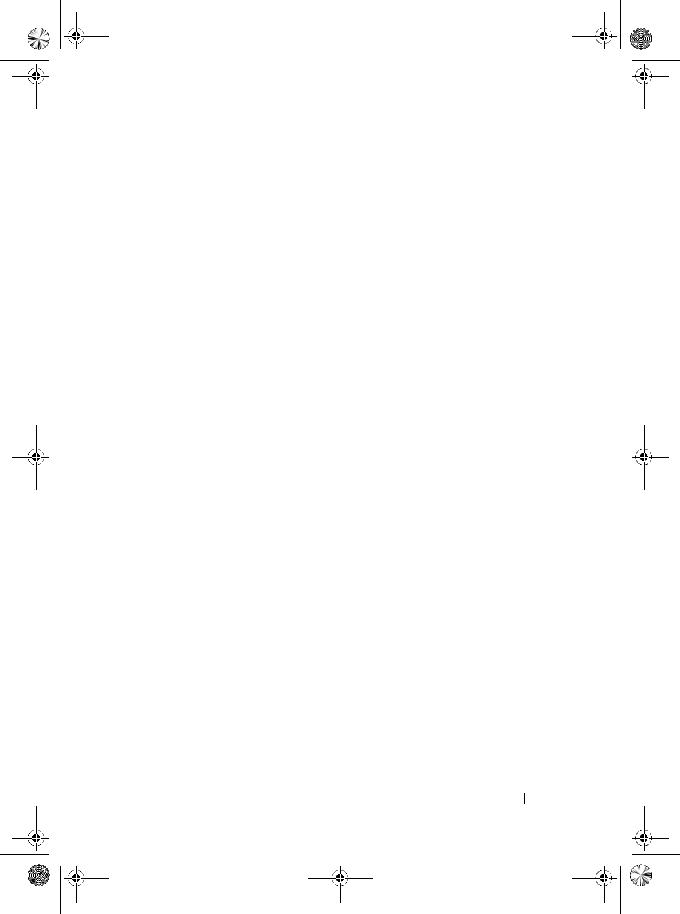
book.book Page 9 Tuesday, November 27, 2007 10:29 AM
Coin-Cell Battery . . . . . . . . . . . . . . . . . . . . |
170 |
Replacing the Coin-Cell Battery . . . . . . . . . . |
170 |
Replacing the Computer Cover . . . . . . . . . . . . . |
172 |
A Appendix . . . . . . . . . . . . . . . . . . . . . . . . 173
Specifications . . . . . . . . . . . . . . . . . . . . . . |
173 |
System Setup . . . . . . . . . . . . . . . . . . . . . . |
178 |
Overview . . . . . . . . . . . . . . . . . . . . . . |
178 |
Entering System Setup . . . . . . . . . . . . . . . |
179 |
System Setup Options . . . . . . . . . . . . . . . |
180 |
Boot Sequence . . . . . . . . . . . . . . . . . . . |
186 |
Clearing Forgotten Passwords . . . . . . . . . . . . . |
188 |
Clearing CMOS Settings . . . . . . . . . . . . . . . . |
190 |
Cleaning Your Computer . . . . . . . . . . . . . . . . |
191 |
Computer, Keyboard, and Monitor . . . . . . . . . |
191 |
Mouse . . . . . . . . . . . . . . . . . . . . . . . |
191 |
Floppy Drive . . . . . . . . . . . . . . . . . . . . |
192 |
CDs and DVDs . . . . . . . . . . . . . . . . . . . |
192 |
FCC Notices (U.S. Only) . . . . . . . . . . . . . . . . . |
193 |
Class A . . . . . . . . . . . . . . . . . . . . . . . |
193 |
Class B . . . . . . . . . . . . . . . . . . . . . . . |
194 |
FCC Identification Information . . . . . . . . . . . |
194 |
Getting Help . . . . . . . . . . . . . . . . . . . . . . . |
195 |
Obtaining Assistance . . . . . . . . . . . . . . . |
195 |
Technical Support and Customer Service . . . . . |
196 |
DellConnect . . . . . . . . . . . . . . . . . . . . |
196 |
Online Services . . . . . . . . . . . . . . . . . . |
196 |
Contents 9
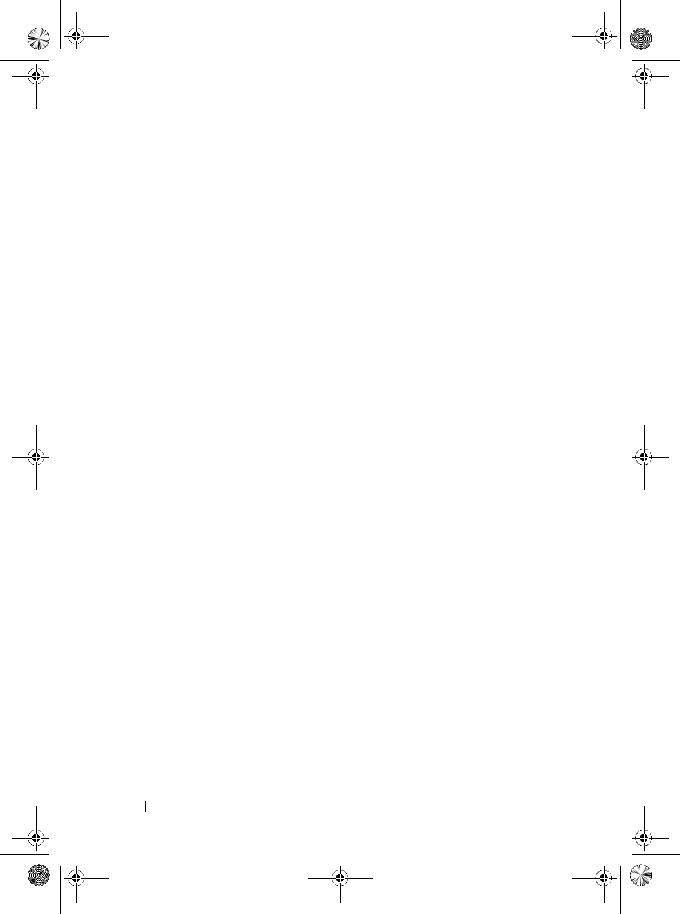
book.book Page 10 Tuesday, November 27, 2007 10:29 AM
AutoTech Service . . . . . . . . . . . . . . . . . . |
197 |
Automated Order-Status Service . . . . . . . . . |
197 |
Problems With Your Order . . . . . . . . . . . . . . . . |
197 |
Product Information . . . . . . . . . . . . . . . . . . . |
197 |
Returning Items for Warranty Repair or Credit . . . . . |
198 |
Before You Call . . . . . . . . . . . . . . . . . . . . . |
198 |
Contacting Dell . . . . . . . . . . . . . . . . . . . . . |
200 |
Glossary . . . . . . . . . . . . . . . . . . . . . . . . . . . |
201 |
Index . . . . . . . . . . . . . . . . . . . . . . . . . . . . . . |
219 |
10 Contents

book.book Page 11 Tuesday, November 27, 2007 10:29 AM
Finding Information
NOTE: Some features or media may be optional and may not ship with your computer. Some features or media may not be available in certain countries.
NOTE: Additional information may ship with your computer.
What Are You Looking For? |
Find It Here |
|
|
• A diagnostic program for my computer Drivers and Utilities Media |
|
• Drivers for my computer |
Documentation and drivers are already |
• My device documentation |
installed on your computer. You can use the |
|
Drivers and Utilities media to reinstall |
||
• Desktop System Software (DSS) |
||
drivers (see "Reinstalling Drivers and |
||
|
||
|
Utilities" on page 91), access your |
|
|
documentation, or run the Dell Diagnostics |
|
|
(see "Dell Diagnostics" on page 86). |
|
|
Readme files may also be included on your |
|
|
media to provide last-minute updates |
|
|
about technical changes to your computer |
|
|
or advanced technical reference material |
|
|
for technicians and experienced users. |
NOTE: Drivers and documentation updates can be found at support.dell.com.
Finding Information |
|
11 |
|
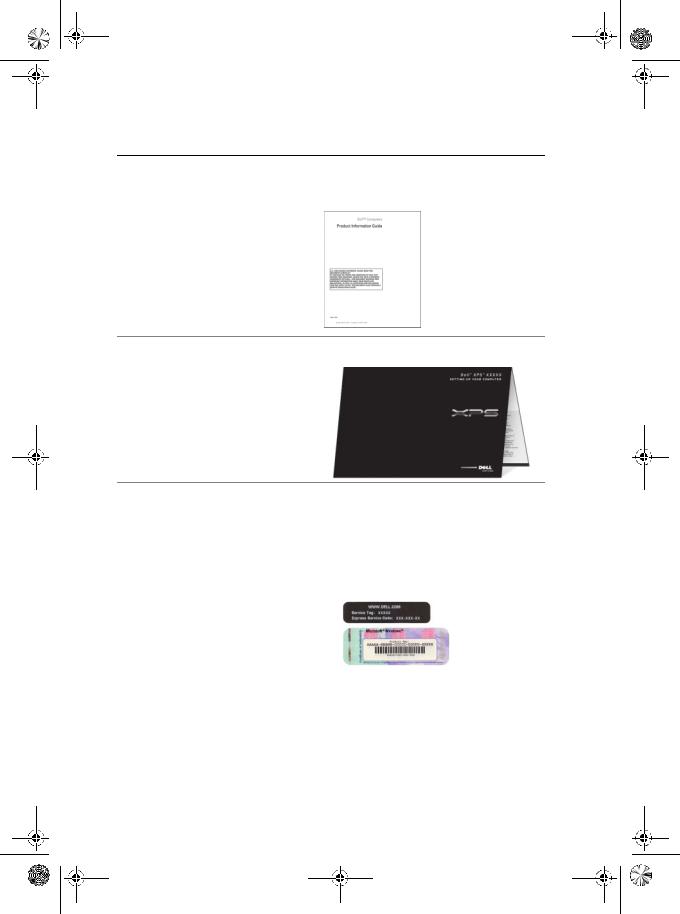
book.book Page 12 Tuesday, November 27, 2007 10:29 AM
What Are You Looking For? |
Find It Here |
|
|
• Warranty information |
Dell™ Product Information Guide |
•Terms and Conditions (U.S. only)
•Safety instructions
•Regulatory information
•Ergonomics information
•End User License Agreement
• How to set up my computer |
Setup Diagram |
•Service Tag and Express Service Code
•Microsoft Windows License Label
Service Tag and Microsoft Windows
Product Key
These labels are located on your computer.
•Use the Service Tag to identify your computer when you use support.dell.com or contact support.
•Enter the Express Service Code to direct your call when contacting support.
NOTE: As an increased security measure, the newly designed Microsoft Windows license label incorporates a missing portion or "hole" to discourage removal of the label.
12 |
Finding Information |

book.book Page 13 Tuesday, November 27, 2007 10:29 AM
What Are You Looking For? |
Find It Here |
|
|
|
|
• Solutions — Troubleshooting hints |
Dell Support Website — support.dell.com |
|
and tips, articles from technicians, |
NOTE: Select your region or business |
|
online courses, and frequently asked |
||
segment to view the appropriate support site. |
||
questions |
||
|
•Community — Online discussion with other Dell customers
•Upgrades — Upgrade information for components, such as the memory, hard drive, and operating system
•Customer Care — Contact information, service call and order status, and warranty and repair information
•Service and Support — Service call status, support history, service contract, and online discussions with support
•Reference — Computer documentation, details on my computer configuration, product specifications, and white papers
•Downloads — Certified drivers, patches, and software updates
•Desktop System Software (DSS) — To download Desktop System Software:
If you reinstall the operating system on your computer, you should also reinstall the DSS utility. DSS automatically detects your computer and operating system and installs the updates appropriate for your configuration, providing critical updates for your operating system and support for Dell™ 3.5-inch USB floppy drives, Intel® Pentium® M processors, optical drives, and USB devices. DSS is necessary for correct operation of your Dell computer.
1 Go to support.dell.com, select your business segment, and then enter your Service Tag or product model.
2 Select Drivers & Downloads, and then click Go.
3 Select your operating system and language, and then search for the keyword
Desktop System Software.
NOTE: The support.dell.com user interface may vary depending on your selections.
Finding Information |
|
13 |
|
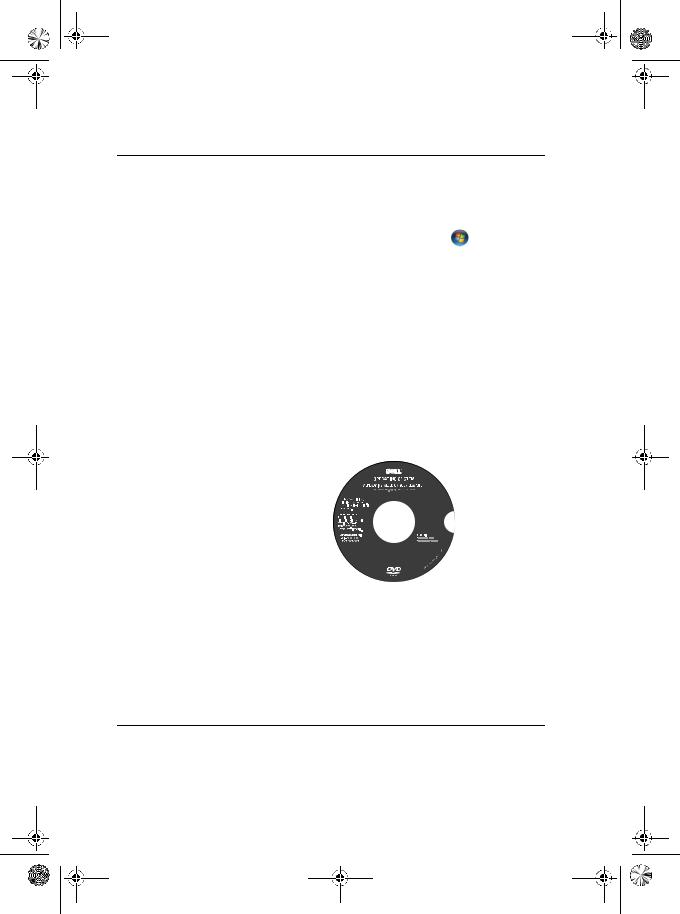
book.book Page 14 Tuesday, November 27, 2007 10:29 AM
What Are You Looking For? |
Find It Here |
|
|
|
|
|
|
• How to use your Windows™ operating |
Windows Help and Support |
|
|
system |
1 |
To access Windows Help and Support: |
|
• How to work with programs and files |
|
• In Windows Vista™, click the Windows |
|
• How to personalize my desktop |
|
Vista Start button™ |
and click |
|
|
Help and Support. |
|
|
2 |
Type a word or phrase that describes your |
|
|
|
problem, and then click the arrow icon. |
|
|
3 |
Click the topic that describes your |
|
|
|
problem. |
|
|
4 |
Follow the instructions on the screen. |
|
|
|
|
|
• How to reinstall my operating system |
Operating System Media |
|
|
|
The operating system is already installed on |
||
your computer. To reinstall your operating system, use the Operating System media (see "Restoring Your Operating System" on page 94).
After you reinstall the operating system, use the Drivers and Utilities media to reinstall drivers for the devices that came with your computer.
The operating system product key label is located on your computer.
NOTE: The color of your Operating System
CD varies according to the operating system you ordered.
14 |
Finding Information |
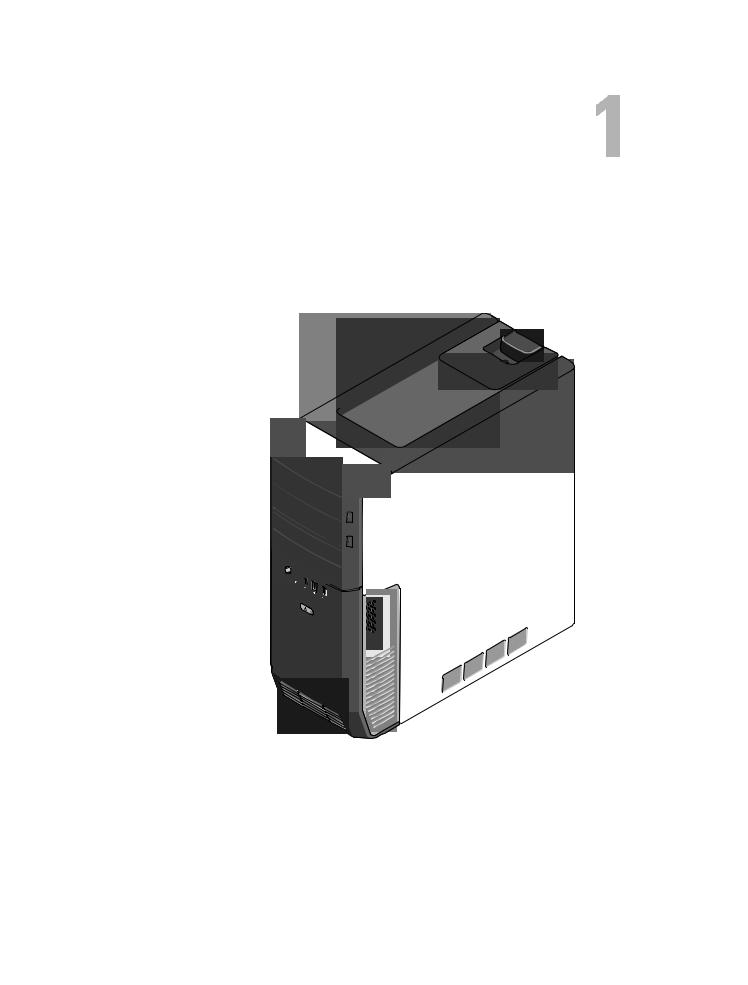
book.book Page 15 Tuesday, November 27, 2007 10:29 AM
Setting Up and Using Your Computer
Front and Back View of the Computer
Front View
17
16
15
14
 13
13
12
11  10
10 


9 
8
7
 6
6
 1
1
 2
2
 3
3
 4
4
 5
5
Setting Up and Using Your Computer |
|
15 |
||
|
||||
|
|
|
|
|
|
|
|
|
|
|
|
|
|
|
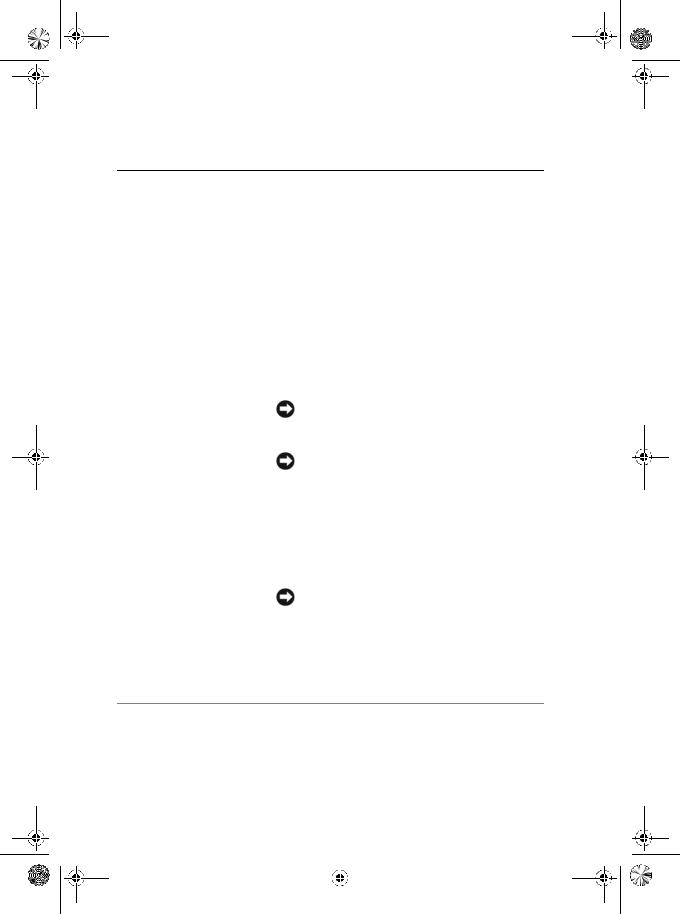
book.book Page 16 Tuesday, November 27, 2007 10:29 AM
1 |
cover release latch |
Use this latch to remove the cover (see "Removing |
|
|
the Computer Cover" on page 101). |
|
|
|
2 |
storage space |
Use to stack CDs, place a digital camera while |
|
|
transferring images to system and so on. |
|
|
|
3 |
LCD display menu |
Use to scroll through the different menu options |
|
|
available on LCD display. |
|
|
|
4 |
LCD navigation |
Use to navigate the menu options on LCD display. |
|
buttons |
Use the buttons to scroll up and down, navigate |
|
|
options on left and right, or select. |
|
|
|
5 |
optical drive tray eject |
Use to eject the drive tray of an optical drive. |
|
button (2) |
NOTE: The self-tending doors on the optical drive open |
|
|
|
|
|
automatically when the eject button is pressed. |
|
|
|
6 |
vents |
For adequate cooling, do not block any of the vents. |
|
|
NOTICE: Ensure that there is a minimum of |
|
|
two inches of space between all vents and any |
|
|
object near the vents. |
|
|
NOTICE: Keep the vent area clean and dust-free |
|
|
to ensure that the system is adequately |
|
|
ventilated. Use only a dry cloth to clean the vent |
|
|
area to avoid water damage to the system. |
|
|
|
7 |
IEEE 1394 connector |
Use the IEEE 1394 connector for high-speed data |
|
|
devices such as digital video cameras and external |
|
|
storage devices. |
|
|
|
8 |
power button |
Press to turn on the computer. |
|
|
NOTICE: To avoid losing data, do not use the |
|
|
power button to turn off the computer. Instead, |
|
|
perform an operating system shutdown. |
NOTE: The power button can also be used to wake the system or to place it into a power-saving state (see "Power Management Options in Windows Vista" on page 56).
16 |
Setting Up and Using Your Computer |
||
|
|
|
|
|
|
|
|
|
|
|
|
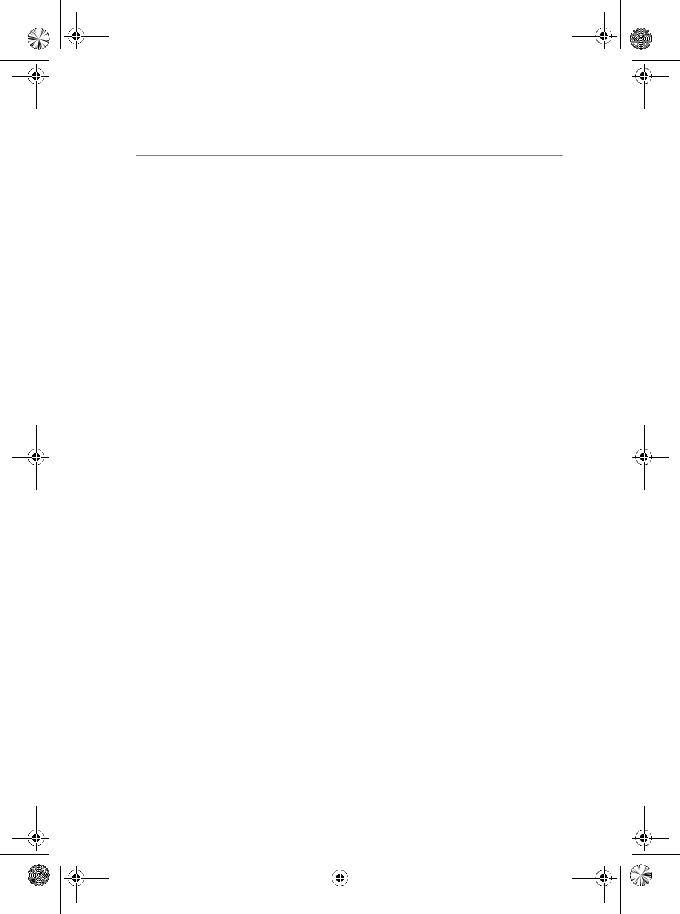
book.book Page 17 Tuesday, November 27, 2007 10:29 AM
9 |
USB connectors (2) |
Use the front USB connectors for devices that you |
|
|
connect occasionally, such as flash memory keys, |
|
|
cameras, or bootable USB devices. For more |
|
|
information on booting to a USB device, see "System |
|
|
Setup" on page 178. |
|
|
NOTE: It is recommended that you use the back USB |
|
|
connectors for devices that typically remain connected, |
|
|
such as printers and keyboards. |
|
|
|
10 |
headphone connector |
Use the headphone connector to attach headphones |
|
|
and most kinds of speakers. |
|
|
|
11 |
microphone connector |
Use the microphone connector to attach a personal |
|
|
computer microphone for voice or musical input into |
|
|
a sound or telephony program. |
|
|
|
12 |
3.5-inch flexbays (2) |
Can hold an optional Media Card Reader, audio |
|
|
input, video input, output device with or without a |
|
|
graphics accelerator device, floppy drive or an |
|
|
additional hard drive. |
|
|
|
13 |
5.25-inch drive bays (2) |
Can hold CD-RW/DVD, audio or video input or |
|
|
output with or without graphics accelerator device, |
|
|
DVD-RW or Blu-ray Disc™. |
|
|
|
14 |
hard-drive activity light |
The hard drive light is on when the computer reads |
|
|
data from or writes data to the hard drive. The light |
|
|
may also be on when a device such as your CD player |
|
|
is operating. |
|
|
|
15 |
diagnostic lights(4) |
Use the sequence of these diagnostics lights to help |
|
|
troubleshoot a problem with your computer (see |
|
|
"Dell Diagnostics" on page 86). |
|
|
|
16 |
network indicator light |
The network link light is on when a good connection |
|
|
exists between a network and the computer. |
|
|
|
17 |
LCD display |
Displays a “Now playing” screen for audio and video |
|
|
applications. Allows you to navigate, select, and |
|
|
launch devices available on your system. |
|
|
|
Setting Up and Using Your Computer |
|
17 |
||
|
||||
|
|
|
|
|
|
|
|
|
|
|
|
|
|
|
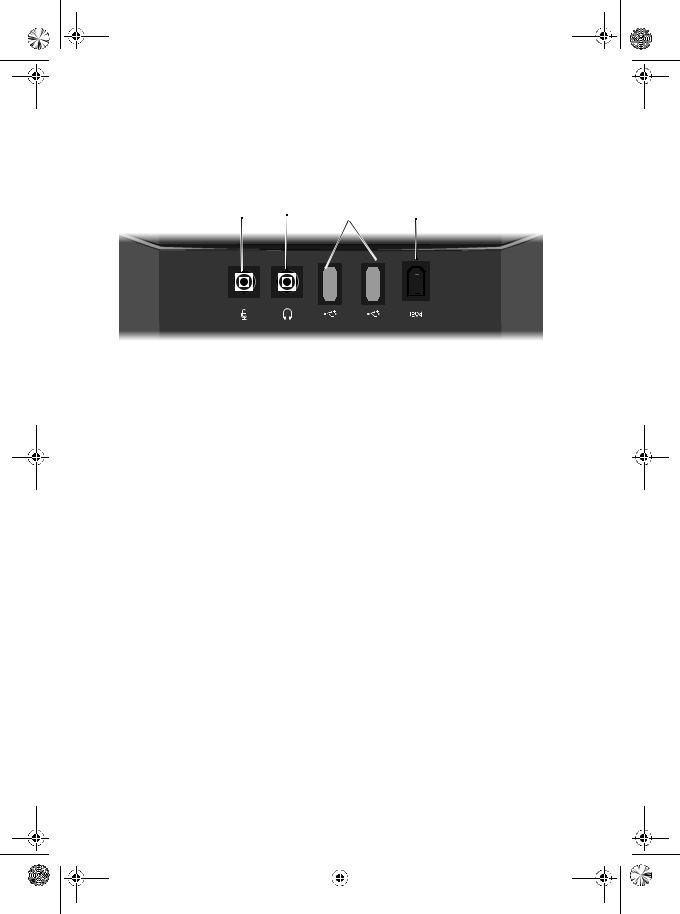
book.book Page 18 Tuesday, November 27, 2007 10:29 AM
Front I/O Connectors
1 |
2 |
3 |
4 |
|
|
||||||
|
|
|
|
|
|
|
|
|
|
|
|
|
|
|
|
|
|
|
|
|
|
|
|
|
|
|
|
|
|
|
|
|
|
|
|
|
|
|
|
|
|
|
|
|
|
|
|
|
|
|
|
|
|
|
|
|
|
|
|
1 |
microphone |
Use the microphone connector to attach a personal |
|
connector |
computer microphone for voice or musical input into a |
|
|
sound or telephony program. |
|
|
|
2 |
headphone |
Use the headphone connector to attach headphones. |
|
connector |
|
|
|
|
3 |
USB connectors (2) |
Use the front USB connectors for devices that you |
|
|
connect occasionally, such as flash memory keys, cameras, |
|
|
or bootable USB devices. For more information on |
|
|
bootable USB devices see "Boot Sequence" on page 186. |
|
|
It is recommended that you use the back USB connectors |
|
|
for devices that typically remain connected, such as |
|
|
printers and keyboards. |
|
|
|
4 |
IEEE 1394 |
Use the IEEE 1394 connector for high-speed data devices |
|
connector |
such as digital video cameras and external storage |
|
|
devices. |
|
|
|
18 |
Setting Up and Using Your Computer |
||
|
|
|
|
|
|
|
|
|
|
|
|

book.book Page 19 Tuesday, November 27, 2007 10:29 AM
Back View
1 |
|
2 |
8 |
|
|
3 |
|
4 |
7 |
5 |
6
1 |
power connector |
Insert the power cable. The appearance of this connector |
|
|
may differ from what is pictured. |
|
|
|
2 |
audio connectors |
Connect appropriate audio devices (see "Back I/O |
|
|
Connectors" on page 20). |
|
|
|
3 |
USB connectors |
Recommended for devices that typically remain connected, |
|
|
such as printers and keyboards. |
|
|
|
4 |
S/PDIF (RCA) |
Connects to external digital stereo speakers. |
|
|
|
5 |
eSATA |
Use it to connect to additional storage devices. |
|
|
|
Setting Up and Using Your Computer |
|
19 |
||
|
||||
|
|
|
|
|
|
|
|
|
|
|
|
|
|
|
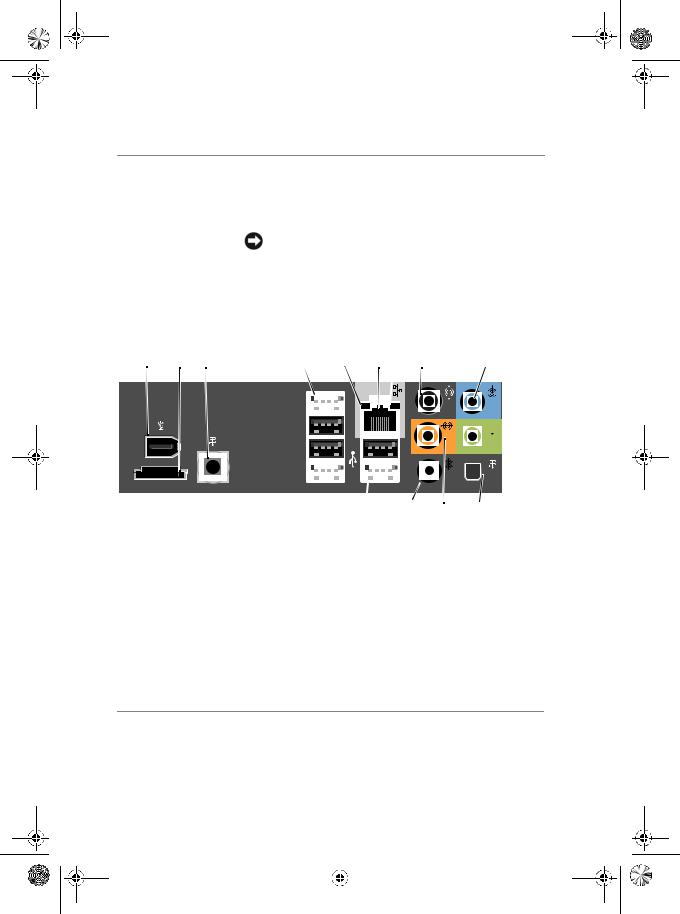
book.book Page 20 Tuesday, November 27, 2007 10:29 AM
6 |
card slots |
|
Access connectors for any installed PCI or PCI Express cards. |
||||||||||
|
|
|
|
NOTE: Some connector slots support full-length cards. |
|||||||||
|
|
|
|
|
|
|
|
|
|||||
7 |
IEEE 1394 |
|
Use the IEEE 1394 connector for high-speed data devices |
||||||||||
|
|
|
|
such as digital video cameras and external storage devices. |
|||||||||
|
|
|
|
|
|
|
|
||||||
8 |
network adapter |
NOTICE: Do not plug a telephone cable into the network |
|||||||||||
|
connector |
|
connector. |
|
|
|
|
|
|
||||
|
|
|
|
Use the network adapter connector to attach your computer |
|||||||||
|
|
|
|
to a network or broadband device. |
|
|
|||||||
|
|
|
|
|
|
|
|
|
|
|
|||
Back I/O Connectors |
|
|
|
|
|
|
|
|
|
|
|||
|
1 |
2 |
3 |
4 |
|
|
|
5 |
6 |
7 |
|
8 |
9 |
|
|
|
|
|
|
|
|
|
|
|
|
|
|
|
|
|
|
|
|
|
|
|
|
|
|
|
|
|
|
|
|
|
|
|
|
|
|
|
|
|
|
|
|
|
|
|
|
|
|
|
|
|
|
|
|
|
|
|
|
|
|
|
|
|
|
|
|
|
|



 10
10
|
|
|
|
|
|
|
|
|
|
|
|
|
|
|
|
|
|
|
|
|
|
|
|
|
|
|
|
|
|
|
|
|
|
|
|
|
|
|
|
|
|
|
|
|
|
|
|
|
|
|
|
|
|
|
|
|
|
|
|
|
|
|
|
|
|
|
|
|
|
|
|
|
|
|
|
|
|
|
|
|
|
|
|
|
|
|
|
|
|
|
|
|
|
|
|
|
|
|
|
|
|
|
|
|
|
|
|
|
|
|
|
|
|
|
|
|
|
|
|
|
|
|
|
|
|
|
|
|
|
|
|
|
|
|
|
|
|
|
|
|
|
|
|
|
|
|
|
|
|
|
|
|
|
|
|
|
|
|
|
|
|
|
|
|
|
|
|
|
|
14 |
|
13 |
12 |
|
11 |
|
|||||||
|
|
|
|
|
|
|
|
|
|
|
|
|
|
|
|
|
|
|
|
|
|
|
1 |
|
|
|
IEEE 1394 |
Use the IEEE 1394 connector for high-speed data devices |
|||||||||||||||||
|
|
|
|
|
|
|
|
|
such as digital video cameras and external storage devices. |
|||||||||||||
|
|
|
|
|
|
|
|
|
|
|
|
|
|
|
|
|
|
|
|
|
|
|
2 |
|
|
|
eSATA |
Use this connector to connect to external SATA storage |
|||||||||||||||||
|
|
|
|
|
|
|
|
|
devices. |
|
|
|
|
|
|
|||||||
|
|
|
|
|
|
|
|
|
|
|
|
|
|
|
|
|
|
|
|
|
|
|
3 |
|
|
|
S/PDIF (RCA) |
Connects to external digital stereo speakers. |
|
|
|||||||||||||||
|
|
|
|
|
|
|
|
|
|
|
|
|
|
|
|
|
|
|
|
|
|
|
4 |
|
|
|
USB connectors |
Use the back, rear-quad USB connectors for devices that |
|||||||||||||||||
|
|
|
|
(4)(rear quad) |
typically remain connected, such as printers and keyboards. |
|||||||||||||||||
NOTE: It is recommended that you use the front USB connectors for devices that you connect occasionally, such as joysticks, cameras, or bootable USB devices.
20 |
Setting Up and Using Your Computer |
||
|
|
|
|
|
|
|
|
|
|
|
|
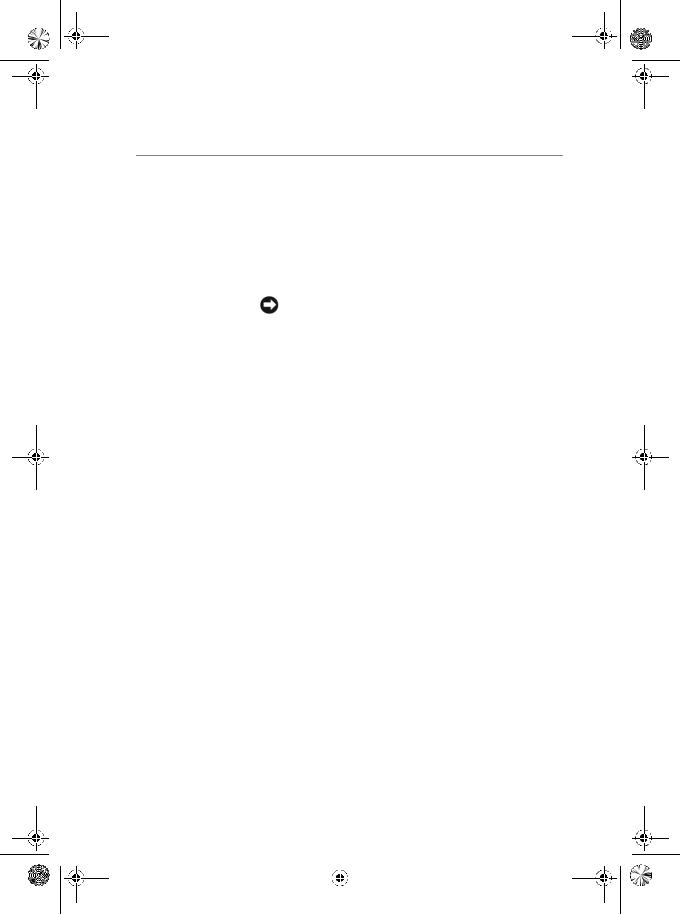
book.book Page 21 Tuesday, November 27, 2007 10:29 AM
5 |
link integrity |
• Green — A good connection exists between a 10-Mbps |
|
light |
network and the computer. |
|
|
• Orange — A good connection exists between a 100-Mbps |
|
|
network and the computer. |
|
|
• Yellow — A good connection exists between a 1000-Mbps |
|
|
(1-Gbps) network and the computer. |
|
|
• Off — The computer is not detecting a physical connection |
|
|
to the network. |
|
|
|
6 |
network adapter |
NOTICE: Do not plug a telephone cable into the network |
|
connector |
adapter connector. |
|
|
Use the network adapter connector to attach your computer |
|
|
to a network or broadband device. Connect one end of a |
|
|
network cable to either a network jack or your network or |
|
|
broadband device, and then connect the other end of the |
|
|
network cable to the network adapter connector on your |
|
|
computer. A click indicates that the network cable has been |
|
|
securely attached. |
|
|
On computers with an additional network connector card, |
|
|
use the connectors on the card and on the back of the |
|
|
computer when setting up multiple network connections |
|
|
(such as a separate intraand extranet). |
|
|
NOTE: It is recommended that you use Category 5 wiring and |
|
|
connectors for your network. If you must use Category 3 wiring, |
|
|
force the network speed to 10 Mbps to ensure reliable |
|
|
operation. |
|
|
|
7 |
network activity |
Flashes a yellow light when the computer is transmitting or |
|
light |
receiving network data. A high volume of network traffic may |
|
|
make this light appear to be in a steady "on" state. |
|
|
|
8 |
surround sound |
Use the (black) surround sound connector to attach |
|
connector |
multichannel-capable speakers. |
|
|
On computers with a sound card, use the connector on the card. |
|
|
|
9 |
line-in |
Use the (blue) line-in connector to attach a record/playback |
|
connector |
device such as a cassette player, CD player, or VCR. |
|
|
On computers with a sound card, use the connector on the card. |
|
|
|
10 |
line- |
Use the (green) line-out connector to attach headphones |
|
out/headphone |
and most speakers with integrated amplifiers. |
|
connector |
On computers with a sound card, use the connector on the card. |
|
|
|
|
|
|
Setting Up and Using Your Computer |
|
21 |
||
|
||||
|
|
|
|
|
|
|
|
|
|
|
|
|
|
|

book.book Page 22 Tuesday, November 27, 2007 10:29 AM
11 |
S/PDIF |
Use the S/PDIF optical connector to transmit digital audio |
|
(optical) |
without going through an analog audio conversion process. |
|
connector |
On computers with a sound card, use the connector on the card. |
|
|
|
|
|
|
12 |
center/subwoof |
Use the (orange) center/subwoofer connector to attach a |
|
er LFE |
center speaker or a single subwoofer. |
|
connector |
On computers with a sound card, use the connector on the card. |
|
|
|
|
|
NOTE: The LFE (Low Frequency Effects) Audio channel, found |
|
|
in digital surround sound audio schemes, carries only low |
|
|
frequency information of 80 Hz and below. The LFE channel |
|
|
drives a subwoofer to provide extremely low bass extension. |
|
|
Systems not using subwoofers can shunt the LFE information to |
|
|
the main speakers in the surround sound setup. |
|
|
|
13 |
side surround |
Use the (gray) side surround sound connector to attach |
|
sound |
multichannel-capable speakers. The side-surround output |
|
connector |
provides enhanced surround audio for computers with |
|
|
7.1 speakers. |
|
|
On computers with a sound card, use the connector on the card. |
|
|
|
14 |
USB 2.0 |
Use the back, rear-dual USB connectors for devices that |
|
connectors (2) |
typically remain connected, such as printers and keyboards. |
(rear dual) |
NOTE: It is recommended that you use the front USB |
|
|
|
connectors for devices that you connect occasionally, such as |
|
joysticks, cameras, or bootable USB devices. |
|
|
Installing Your Computer in an Enclosure
Installing your computer in an enclosure can restrict the airflow and impact your computer’s performance, possibly causing it to overheat. Follow the guidelines below when installing your computer in an enclosure:
NOTICE: The operating temperature specifications indicated in your Owner’s Manual reflect the maximum ambient operating temperature. The room’s ambient temperature needs to be a consideration when installing your computer in an enclosure. For example, if the ambient room temperature is at 25° C (77° F), depending on your computer’s specifications, you only have 5° to 10° C (9° to 18° F) temperature margin before you reach your computer’s maximum operating temperature. For details about your computer’s specifications, see "Specifications" on page 173.
22 |
Setting Up and Using Your Computer |
||
|
|
|
|
|
|
|
|
|
|
|
|
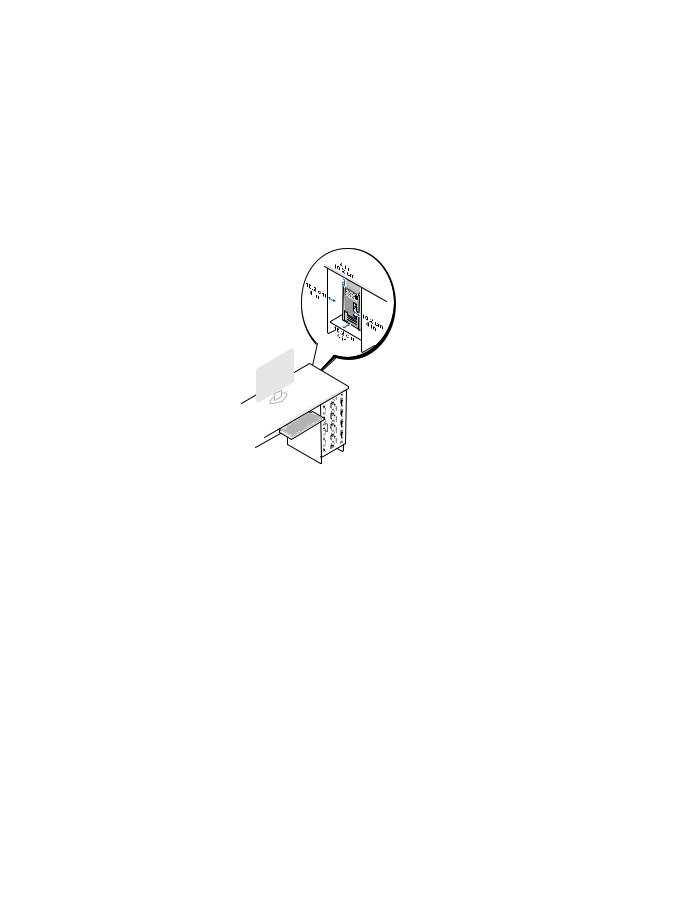
 book.book Page 23 Tuesday, November 27, 2007 10:29 AM
book.book Page 23 Tuesday, November 27, 2007 10:29 AM
•Leave a 10.2 centimeter (4 inch) minimum clearance on all vented sides of the computer to permit the airflow required for proper ventilation.
•If your enclosure has doors, they need to be of a type that allows at least 30% airflow through the enclosure (front and back).
•If your computer is installed in a corner on a desk or under a desk, leave at least 5.1 centimeters (2 inch) of clearance from the back of the computer to the wall to permit the airflow required for proper ventilation.
|
|
|
|
Setting Up and Using Your Computer |
|
23 |
||
|
|
|
|
|
||||
|
|
|
|
|
||||
|
||||||||
|
|
|
|
|
|
|
|
|
|
|
|
|
|
|
|
|
|
|
|
|
|
|
|
|
|
|

 book.book Page 24 Tuesday, November 27, 2007 10:29 AM
book.book Page 24 Tuesday, November 27, 2007 10:29 AM
•Do not install your computer in an enclosure that does not allow airflow.
Restricting the airflow impacts your computer’s performance, possibly causing it to overheat.
Connecting Monitors
CAUTION: Before you perform any of the procedures in this section, follow the safety instructions in the Product Information Guide.
CAUTION: To reduce the risk of fire, electric shock, or injury, do not overload an electrical outlet, power strip, or convenience receptacle. The total ampere rating of all products plugged into an electrical outlet, power strip, or other receptacle should not exceed 80 percent of the branch circuit rating.
NOTE: Your video card has three different ports: a DVI (White) port, a DVI-I (Black) port , and a VGA (Blue) port.
24 |
Setting Up and Using Your Computer |
||
|
|
|
|
|
|
|
|
|
|
|
|
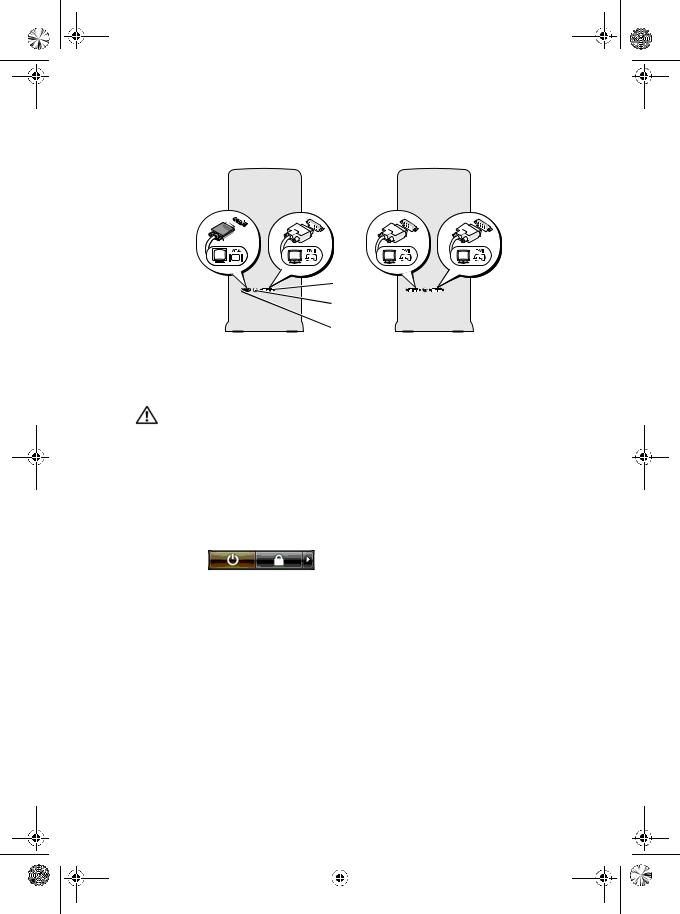
book.book Page 25 Tuesday, November 27, 2007 10:29 AM
1 |
 2
2
 3
3
1 DVI (white) connector 2 TV-OUT connector 3 VGA (blue) connector
Connecting a Monitor (Without an Adapter)
CAUTION: Before you perform any of the procedures in this section, follow the safety instructions in the Product Information Guide.
1Save and close all open files and exit all open programs.
2Shut down the operating system:
•In Windows Vista™, click the Windows Vista Start button™  click the arrow in the lower-right corner of the Start menu as shown below, and then click Shut Down.
click the arrow in the lower-right corner of the Start menu as shown below, and then click Shut Down.
The computer turns off after the operating system shutdown process is complete.
3Ensure that the computer and all attached devices are turned off. If your computer and attached devices did not automatically turn off when you shut down your operating system, press and hold the power button for about 4 seconds to turn them off.Disconnect the computer and all attached devices from their electrical outlets.
Setting Up and Using Your Computer |
|
25 |
||
|
||||
|
|
|
|
|
|
|
|
|
|
|
|
|
|
|
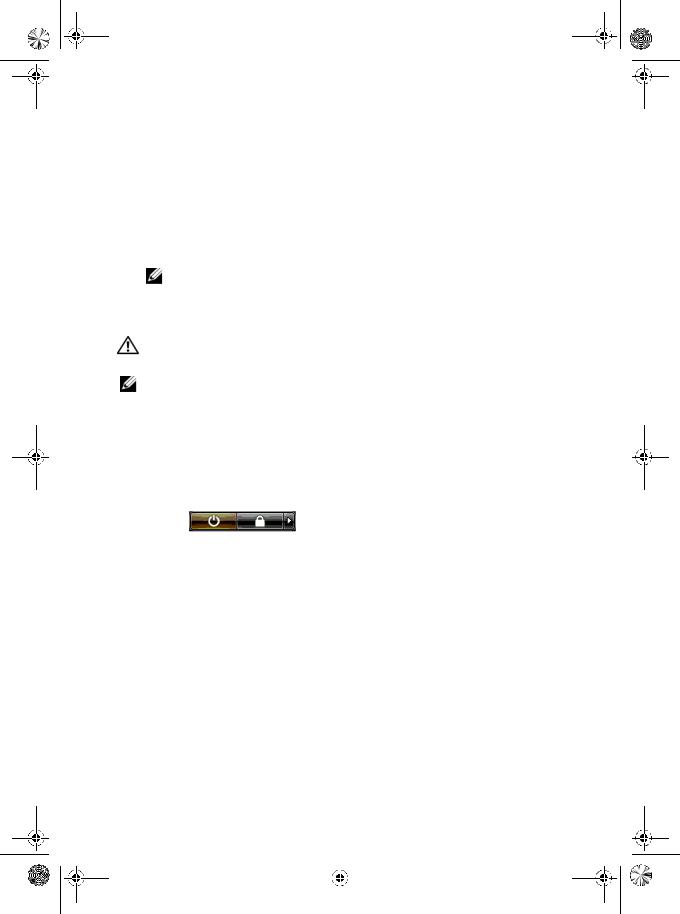
book.book Page 26 Tuesday, November 27, 2007 10:29 AM
4Connect the DVI or VGA connector of your monitor to the appropriate connector on the back of the computer:
To connect a monitor with a DVI connector, use the (white) DVI port on your computer.
To connect a monitor with a VGA connector, use the (blue) VGA port on your computer.
NOTE: To connect a monitor with a VGA connector to the DVI-I (black) port on your computer, use a dongle.
Connecting a Monitor (With an Adapter)
CAUTION: Before you perform any of the procedures in this section, follow the safety instructions in the Product Information Guide.
NOTE: In order to connect a monitor with a VGA connector to the DVI port on the back of your computer, a DVI-to-VGA adapter is required.
1Save and close all open files and exit all open programs.
2Shut down the operating system:
•In Windows Vista, click Start  , click the arrow in the lower-right corner of the Start menu as shown below, and then click Shut Down.
, click the arrow in the lower-right corner of the Start menu as shown below, and then click Shut Down.
The computer turns off after the operating system shutdown process is complete.
26 |
Setting Up and Using Your Computer |
||
|
|
|
|
|
|
|
|
|
|
|
|
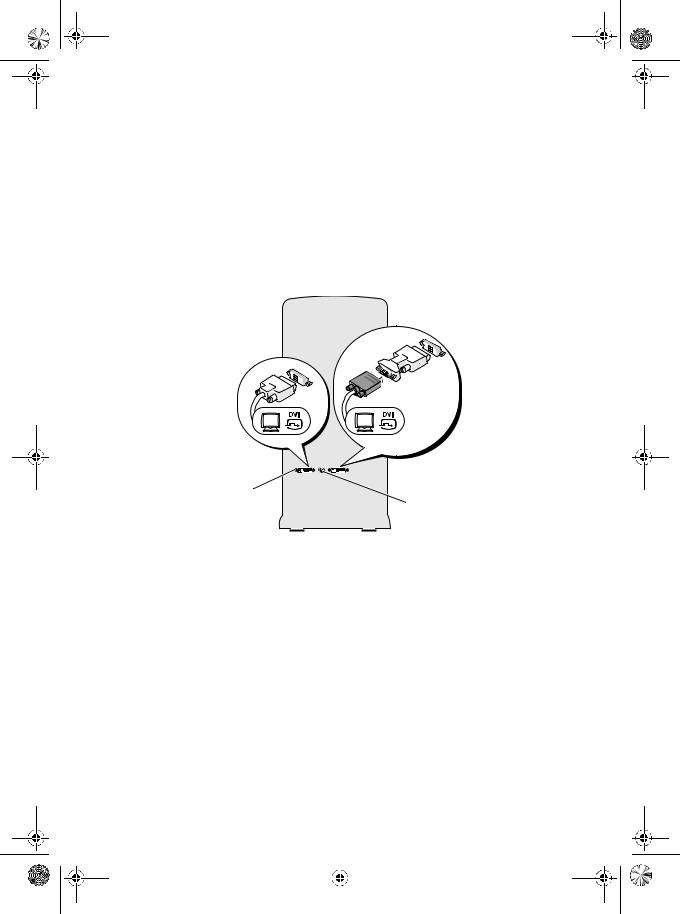
book.book Page 27 Tuesday, November 27, 2007 10:29 AM
3Ensure that the computer and all attached devices are turned off. If your computer and attached devices did not automatically turn off when you shut down your operating system, press and hold the power button for about 4 seconds to turn them off.
4Connect the DVI-to-VGA adapter to the VGA connector on your monitor, and then connect the other end of the adapter to the (white) DVI port on the back of the computer.
 2
2
1 |
 3
3
1 DVI (white) connector 2 DVI-to-VGA adapter 3 TV-OUT connector (optional)
Setting Up and Using Your Computer |
|
27 |
||
|
||||
|
|
|
|
|
|
|
|
|
|
|
|
|
|
|
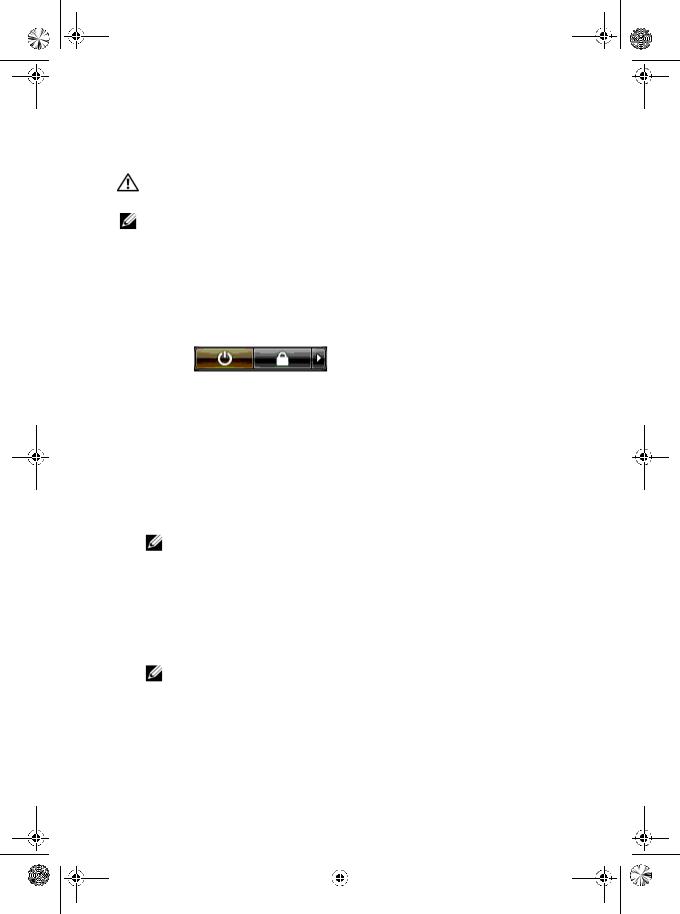
book.book Page 28 Tuesday, November 27, 2007 10:29 AM
Connecting Two or More Monitors
CAUTION: Before you perform any of the procedures in this section, follow the safety instructions in the Product Information Guide.
NOTE: Your video card has one DVI (white) port, one DVI-I (black) port, and one VGA (blue) port.
1Save and close all open files and exit all open programs.
2Shut down the operating system:
•In Windows Vista, click Start  , click the arrow in the lower-right corner of the Start menu as shown below, and then click Shut Down.
, click the arrow in the lower-right corner of the Start menu as shown below, and then click Shut Down.
The computer turns off after the operating system shutdown process is complete.
3Ensure that the computer and all attached devices are turned off. If your computer and attached devices did not automatically turn off when you shut down your operating system, press and hold the power button for about 4 seconds to turn them off.
4Connect two or more monitors to the appropriate DVI or VGA ports on the back of the computer.
NOTE: In order to connect a monitor with a VGA connector to the DVI port on the back of your computer, a DVI-to-VGA adapter is required.
To connect two or more monitors directly to the DVI or VGA ports on your computer, see "Connecting a Monitor (Without an Adapter)" on page 25.
To connect the VGA connectors of one or more monitors to the DVI port(s) on your computer, see "Connecting a Monitor (With an Adapter)" on page 26.
NOTE: To connect a monitor with a VGA connector to the DVI-I (black) port on your computer, use a dongle.
5Change the display settings to support multiple monitors (see "Changing the Display Settings" on page 30).
28 |
Setting Up and Using Your Computer |
||
|
|
|
|
|
|
|
|
|
|
|
|
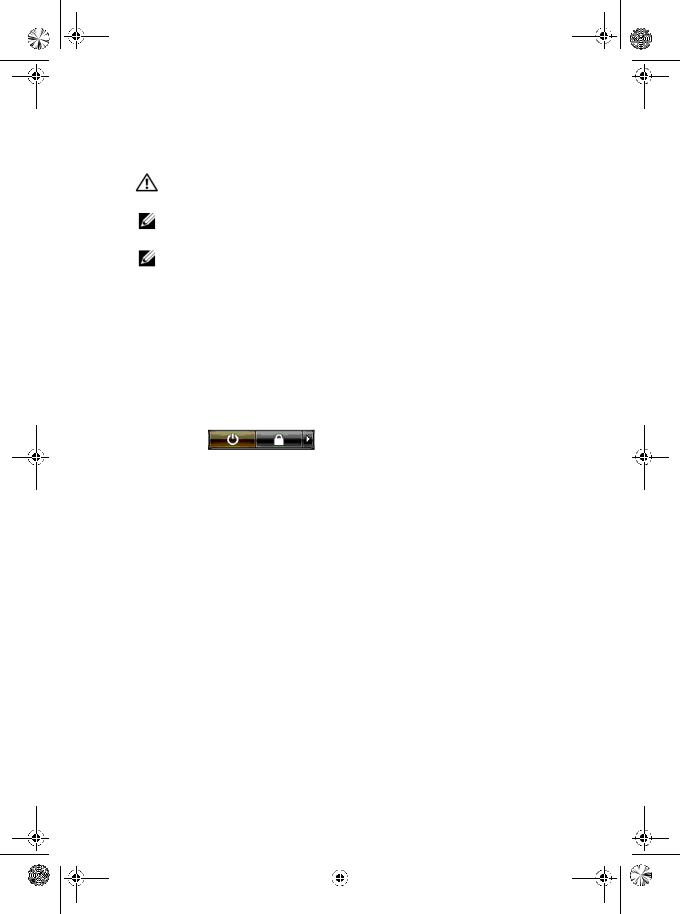
book.book Page 29 Tuesday, November 27, 2007 10:29 AM
Connecting a TV
CAUTION: Before you perform any of the procedures in this section, follow the safety instructions in the Product Information Guide.
NOTE: If you are connecting a TV to your computer, you may connect only one monitor (VGA or DVI) in addition to the TV.
NOTE: See the documentation that came with your TV to ensure that you properly configure and connect the TV.
To connect a TV to your computer, an S-video cable is required. If you do not have an S-video cable, you may purchase one at most consumer electronics stores. An S-video cable is not included with your computer.
1Save and close all open files and exit all open programs.
2Shut down the operating system:
•In Windows Vista, click Start  , click the arrow in the lower-right corner of the Start menu as shown below, and then click Shut Down.
, click the arrow in the lower-right corner of the Start menu as shown below, and then click Shut Down.
The computer turns off after the operating system shutdown process is complete.
3Ensure that the computer and all attached devices are turned off. If your computer and attached devices did not automatically turn off when you shut down your operating system, press and hold the power button for about 4 seconds to turn them off.
4Disconnect the computer and all attached devices from their electrical outlets.
5Connect one end of the S-video cable to the TV-OUT connector on the back of the computer.
6Connect the other end of the S-video cable to the S-video input connector on your TV.
7Connect one monitor, as needed, with a DVI or VGA connector as described in "Connecting Monitors" on page 24.
Setting Up and Using Your Computer |
|
29 |
||
|
||||
|
|
|
|
|
|
|
|
|
|
|
|
|
|
|
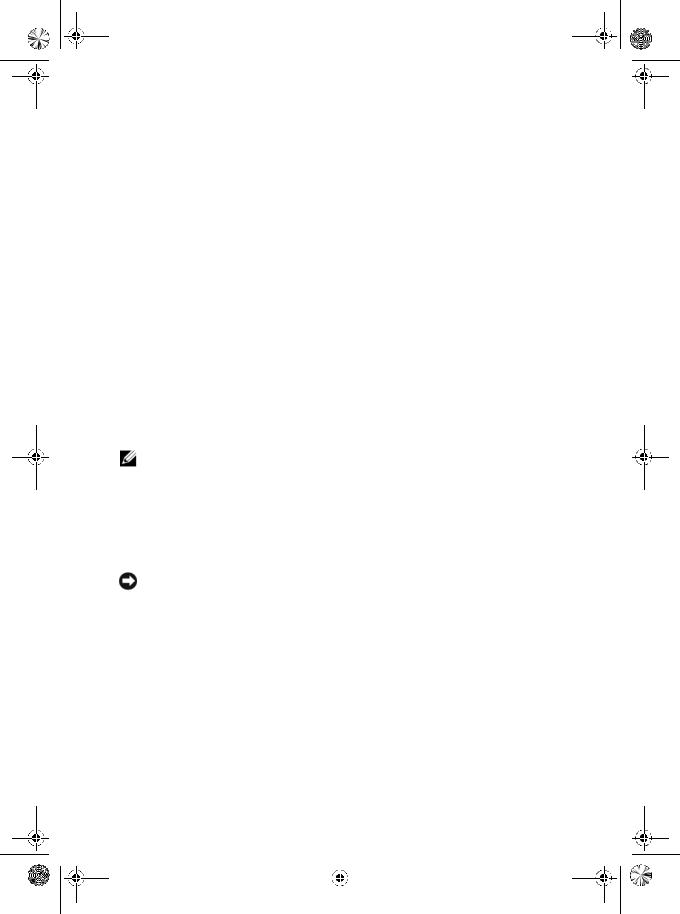
book.book Page 30 Tuesday, November 27, 2007 10:29 AM
Changing the Display Settings
1After you connect the monitor(s) or TV, turn on the computer.
The Microsoft® Windows® desktop displays on the primary monitor.
2Enable extended desktop mode in the display settings. In extended desktop mode, you can drag objects from one screen to the other, effectively doubling the amount of viewable work space.
About Your RAID Configuration
This section provides an overview of the RAID configuration you may have selected when you purchased your computer. There are several RAID configurations available in the computer industry for different types of uses. Your computer supports RAID level 0 and RAID level 1. A RAID level 0 configuration is recommended for high-performance programs or gaming, and a RAID level 1 configuration is recommended for users who require a high level of data integrity. For example, those in the digital photography and audio industries.
NOTE: RAID levels do not represent a hierarchy. A RAID level 1 configuration is not inherently better or worse than a RAID level 0 configuration.
The drives in a RAID configuration should be the same size in order to ensure that the larger drive does not contain unallocated (and therefore unusable) space.
RAID Level 0 Configuration
NOTICE: Because RAID level 0 configurations provide no data redundancy, a failure of one drive results in the loss of all data (the data on the remaining drive is also inaccessible). Therefore, ensure that you perform regular backups when you use a RAID level 0 configuration.
A RAID level 0 configuration uses a storage technique known as data striping to provide a high data access rate. Data striping is a method of writing consecutive segments, or stripes, of data sequentially across the physical drives to create a large virtual drive. Data striping allows one of the drives to read data while the other drive is searching for and reading the next block.
30 |
Setting Up and Using Your Computer |
||
|
|
|
|
|
|
|
|
|
|
|
|
